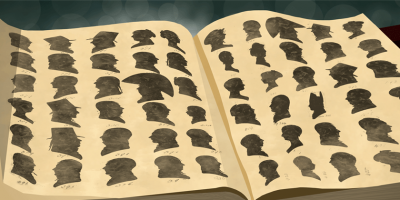
Before the invention of photography, only the rich could afford to have portraits of themselves. But in the early 1800s, a device called the physiognotrace democratized portraiture, making it possible for everyday people to have their images captured in silhouettes. A man named William Bache traveled the United States creating hundreds of silhouette portraits with the aid of the physiognotrace. He left behind a ledger book that gives us a rare glimpse of early America—a ledger book laced with poison.
Guests:
- Robyn Asleson, curator of prints and drawings at the Smithsonian’s National Portrait Gallery
- Nora Lockshin, senior conservator for archives at the Smithsonian Libraries and Archives
- Wendy Bellion, Sewell C. Biggs Chair in American Art History, and associate dean for the humanities at the University of Delaware
- Carolyn Hauk, doctoral student in the art history department of the University of Delaware, former intern at the Smithsonian’s National Portrait Gallery
Smithsonian Links:
- Flip through the fully digitized album of more than 1,800 silhouettes from the Smithsonian’s National Portrait Gallery.
- Learn more about the preservation process and precautions taken by conservators in Inside Smithsonian Research magazine (pages 8-9).
- Arsenic was a ubiquitous ingredient into the early 1900’s, present in everything from paints and fabric dyes to beauty products like these edible Arsenic Complexion Wafers, now in the collections of the Smithsonian’s National Museum of American History.
- See more captivating uses of silhouettes in American art from the 18th century through the present day in the Smithsonian’s National Portrait Gallery exhibition, Black Out: Silhouettes Then and Now.
Sign up to unlock the full Sidedoor experience!
Get bonus content, news, and updates in your inbox.
Please enter a valid email address.
